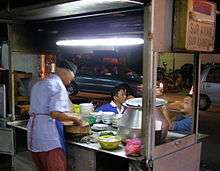Sup kambing
|
Sup kepala kambing, goat's head soup served in Indonesia. | |
| Type | Soup |
|---|---|
| Place of origin | Indonesia, Malaysia |
| Creator | Arab Indonesian cuisine (Indonesia) and Malaysian Indian cuisine (Malaysia and Singapore) |
| Main ingredients | Goat meat or Mutton |
|
| |
Sup Kambing or Sop Kambing is a mutton soup commonly found in Malaysian and Indonesian cuisine.[1] It is prepared with goat meat, tomato, celery, spring onion, ginger, candlenut and lime leaf, its broth is yellowish in color.[1]
In Indonesia, sup kambing is quite widespread as numbers of similar goat meat soup recipes can be found. However, it is mostly associated with Malay of Medan,[2] Betawi[3] and Madura cuisine,[4] although it is also common in Java. Nevertheless, Javanese are more likely to cook their goat meat as tongseng or Javanese-style soupy gulai instead. Traditionally, sup kambing together with gulai and sate kambing are quite widespread during Eid al-Adha, as large amount of goat meat and offals being distributed among people.
In Malaysia, sup kambing is associated with Muslim Malaysian Indian community and believed to be of Indian origin. In Singapore, the dish is also associated with Muslim Indian community in the island.[5]
Ingredients
There are many versions of sup kambing recipes, however there are two main groups of sup kambing traditions; the Indonesian version are derived mainly from Arab, and to some extent, Dutch influences, while Malaysian and Singaporean version is often called as sup kambing Mamak which solely derived from Muslim Indian influences. Other main differences are the Malaysian and Singaporean version consists of the chunks of goat meat in yellowish, rather thick and oily broth with rich spices; while in Indonesian version, the goat meat often also includes its bones (ribs or leg bones), has a lighter broth and balanced spices, and it also contains slices of vegetables including tomato, leek, celery, carrot and sometimes potato.[5]
A simple sup kambing recipe uses goat meat, slices of tomato, leek, celery, and ground spices which includes; ginger, pepper, garlic, shallot and salt.[6] However, another elaborate recipes might add more complex spices, which might includes cardamom, cinnamon, candlenut, nutmeg, clove and star anise to add aroma and taste.[7]
History
Despite its wide popularity in the region, the question of origin however, might be owed to the Arabs and Muslim Indian migrations into the Malay archipelago. In Indonesia, sup kambing is believed to be of Arab origin, brought by the influx of Arabs migrants into the archipelago between the 18th to 19th century, during colonial era.[8] The Arabs settlers introduced and promoted goat, lamb and mutton as their preferred meat, thus several dishes influenced by Arab and Muslim Indian culinary traditions were introduced to Sumatra, Malay peninsula and Java. Around the same period, other mutton or goat-based dishes such as sate kambing, gulai kambing and tongseng were also appeared in Java.[9]
The early Arab immigrants settled in coastal towns of Sumatra and Java, and subsequently influenced the culture of native ethnic groups including Sumatran Malays, the Betawis of Batavia (Jakarta), also Javanese and Madurese of East Java. The sup kambing was adopted by locals, and often linked to Islamic festival of kurban (Eid al-Adha), where large numbers of cattles — including goats, are slaughtered and distributed among people. As the result, despite its Arab origin, today in Indonesia sup kambing is more associated with Malay, Madurese and Betawi cuisine. Indonesian sup kambing uses carrot, tomato and sometimes potato, which hints its European (possibly Portuguese or Dutch) influences. Tomato and potato are not available in Southeast Asia, until European colonials brought them from the Americas around the 17th century. The sup kambing from Medan in North Sumatra however, is more closer to the Malaysian version, since they commonly derived from Muslim Indian culture.

In Malay Peninsula region, which today includes Malaysia and Singapore, the most popular version is sup kambing Mamak which is believed was invented by the Muslim Indian community there, where the use of typical spices is quite notable.[10] There is no exact equivalent of this soup in Indian sub-continent, although the spices used and the style of cooking clearly demonstrates Indian influence.[5] The dish is also adopted by native Malays in the country.
Variations
In Indonesia the soup is prepared in rich savoury broth with spices and ingredients similar to other Indonesian favourite, sop buntut (oxtail soup). Common sop kambing uses goat meat, also its ribs; however, in Indonesia there is a more specific sop kambing called sop kepala kambing which uses offals of goat's head, which includes its tongue, ear, lips and cheek meats, eyes and sometimes brain. Another specific sup kambing is called sop kaki kambing which uses goat's trotters.[11]
See also
External links
- Various Indonesian Sup Kambing recipes (in Indonesian)
- Jakarta-Style Goat Feet Soup from Indonesia Eats
References
- 1 2 "40 of Indonesia's best dishes". CNN Travel. August 9, 2011. Retrieved 9 February 2015.
- ↑ "Sup Kambing Medan (Mutton Soup)". Indonesian Medan Food.
- ↑ "Resep Sop Kambing Betawi Bening yang Asli dan Original Juga Enak dan Lezat". Selerasa (in Indonesian).
- ↑ "Resep Sop Daging Kambing Bening Madura yang Asli dan Enak". Selerasa (in Indonesian).
- 1 2 3 "Sup Kambing". Carry it like Harry.
- ↑ "Sup Kambing Sederhana" (in Indonesian).
- ↑ "Sop kambing" (in Indonesian).
- ↑ "Sop Kambing: Indonesian mutton bone soup". 5 January 2013.
- ↑ Christina Andhika Setyanti (30 August 2016). "Sepotong Sejarah Autentik Indonesia dalam Semangkuk Tongseng". CNN Indonesia (in Indonesian).
- ↑ Wendy Hutton (2007). Singapore Food, Indian Mutton Soup (page 36). Marshall Cavendish. p. 36. ISBN 9789812613219.AC
- ↑ Pepy Nasution (31 October 2011). "Sop Kaki Kambing Jakarta Recipe (Jakarta-Style Goat Feet Soup)". Indonesia Eats.
